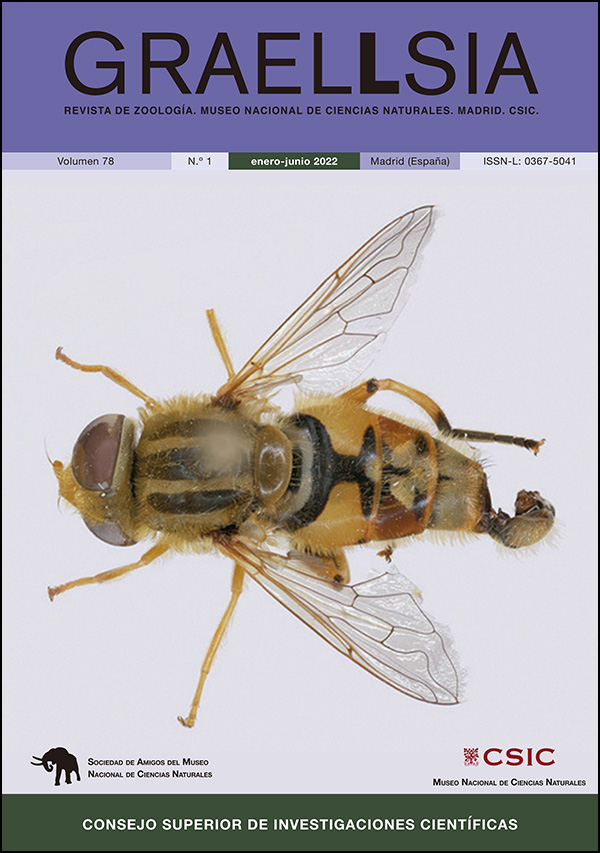Aphis prima sp. n. (Hemiptera, Aphididae), de Argentina y Chile, primera especie de áfido colectada en el Mundo sobre Schoepfiaceae (Santalales)
DOI:
https://doi.org/10.3989/graellsia.2022.v78.337Palabras clave:
Pulgones, áfidos, Aphididae, Aphis, Schoepfiaceae, medial ramificada una vez, especie nueva, Argentina, ChileResumen
Se presenta el estudio de las primeras muestras de pulgones recolectadas en Schoepfiaceae (Santalales). Aphis prima sp. n. se describe a partir de hembras vivíparas colectadas en localidades de las provincias argentinas de Neuquén, Río Negro y Santa Cruz y en la región chilena del Maule sobre plantas de los géneros Quinchamalium y Arjona, que son endémicos de América del Sur. La nueva especie se caracteriza por la presencia de papilas marginales en 5 o 6 segmentos abdominales, tibias pigmentadas homogéneamente y cauda triangular tanto en ápteras como en aladas, de sensorios secundarios en el segmento antenal III en ápteras y de la vena medial de las alas anteriores ramificada una sola vez en aladas. El último carácter de los mencionados es muy raro en la subfamilia Aphidinae.
Descargas
Citas
Angiosperm Phylogeny Group, 2009. An update of the Angiosperm Phylogeny Group classification for the orders and families of flowering plants: APG III. Botanical Journal of the Linnean Society, 161 (2): 105-121. https://doi.org/10.1111/j.1095-8339.2009.00996.x
Angiosperm Phylogeny Group, 2016. An update of the Angiosperm Phylogeny Group classification for the orders and families of flowering plants: APG IV. Botanical Journal of the Linnean Society, 181 (1): 1-20. https://doi.org/10.1111/boj.12385
Blackman, R. L. & Eastop, V. F., 2021. Aphids on World's plants. An online identification and information guide. Available from http://www.aphidsonworldsplants.info/ (accessed October 2021).
Carver, M., 2000. A new indigenous species of Aphis Linnaeus (Hemiptera: Aphididae) on Muehlenbeckia (Polygonaceae) in New Zealand. New Zealand Entomologist, 22: 3-7. https://doi.org/10.1080/00779962.1999.9722049
Franielczyk-Pietyra, B. & Wegierek, P., 2017. The forewing of the Aphis fabae (Scopoli 1763) (Hemiptera, Sternorrhyncha): a morphological and histological study. Zoomorphology 136: 349-358. h https://doi.org/10.1007/s00435-017-0358-7 PMid:28883685 PMCid:PMC5563516
García Prieto, F. & Nieto Nafría, J. M., 2005. Género Aphis. In: Nieto Nafría, J. M., Mier Durante, M. P., García Prieto, F. & Pérez Hidalgo, N. Hemiptera Aphididae III. In M.A. Ramos et al. (eds.). Fauna Ibérica vol. 28: 30-173.
Hassler M., 2019. World Plants: Synonymic Checklists of the Vascular Plants of the World (version Nov 2018). In: Y. Roskov, G. Ower, T. Orrell, D. Nicolson, N. Bailly, P.M. Kirk, T., Bourgoin, R.E. DeWalt, W, Decock, E. van Nieukerken, J. Zarucchi & L. Penev (eds.): Species 2000 & ITIS Catalogue of Life, 2019 Annual Checklist Digital resource at www.catalogueoflife.org/annual-checklist/2019. Species 2000: Naturalis, Leiden, The Netherlands.
Holman, J., 1966. Contributions to the taxonomy of the genus Aphis (Homoptera, Aphididae) - II. Acta Entomologica Bohemoslovaca, 63 (2): 91-110.
Lagos-Kutz, D., Voegtlin, D.J. & Hartman, G., 2017. Identification of a new species of Aphis (Hemiptera: Aphididae) based on distinct morphology rather than DNA barcoding. Insecta Mundi, 0535: 1-11.
López Laphitz, R. M., Ezcurra, C. & Vidal-Russell, R., 2015. Revisión taxonómica del género sudamericano Quinchamalium (Schoepfiaceae). Boletín de la Sociedad Argentina de Botánica, 50 (2): 235-246. https://doi.org/10.31055/1851.2372.v50.n2.11667
Mier Durante, M. P., Nieto Nafría, J. M. & Ortego, J., 2003. Aphidini (Hemiptera: Aphididae) living on Senecio (Asteraceae), with descriptions of a new genus and three new species. The Canadian Entomologist, 135 (2): 187-212. https://doi.org/10.4039/n02-065
Nieto Nafría, J. M., Brown, P. A., López Ciruelos, S. I. & Ortego, J., 2019. A new species of Aphis (Hemiptera Aphididae) living on Troapaeolum species (Tropaeolaceae) from Chile and Argentina. Redia, 102: 35-40. https://doi.org/10.19263/REDIA-102.19.05
Nieto Nafría, J. M. & Mier Durante, M.P. 1998. Hemiptera Aphididae I. In: M.Á. Ramos et al. (Eds). Fauna Ibérica, Volumen 11. Museo Nacional de Ciencias Naturales, CSIC. Madrid. 424 pp.
Nieto Nafría, J.M. & Mier Durante, M.P., 2013. Acyrthosiphon matilei (Hemiptera Aphididae) in the Cantabrian Mountains (Spain). Boletín de la Asociación Española de Entomología, 37 (3-4): 383-384.
Osiadacz, B. & Hałaj, R., 2010. Systematic Review of Aphids of Poland with Host Plant Index. Silesian Natural History Monographs, 1: 1-191. https://doi.org/10.2478/v10200-011-0014-3
Osiadacz, B. & Hałaj, R., 2015. Aphids in jeopardy? Aphid communities on xerothermic habitats. Biologia, 70: 1118-1135, https://doi.org/10.1515/biolog-2015-0119
Pashchenko, N. F., 1993. Tli roda Aphis (Homoptera, Aphidinea, Aphididae) zhivushchiye na rasteniyakh semeytv Lamiaceae, Limoniaceae, Onagraceae, Polemoniaceae, Primilaceae i Santalaceae na Dal'nem Vostoke Rossii {Aphids on the genus Aphis […] living on plants of the families […] in the Russian Far East}. Zoologicheskiy Zhurnal, 72 (10): 41-53.
Vidal-Russell, R., 2019. Phylogenetic Relationships in Arjona (Schoepfiaceae), a hemiparasitic herb from Southern South America. Systematic Botany, 44 (3): 592-599. https://doi.org/10.1600/036364419X15620113920626
Publicado
Cómo citar
Número
Sección
Licencia
Derechos de autor 2022 Consejo Superior de Investigaciones Científicas (CSIC)

Esta obra está bajo una licencia internacional Creative Commons Atribución 4.0.
© CSIC. Los originales publicados en las ediciones impresa y electrónica de esta Revista son propiedad del Consejo Superior de Investigaciones Científicas, siendo necesario citar la procedencia en cualquier reproducción parcial o total.
Salvo indicación contraria, todos los contenidos de la edición electrónica se distribuyen bajo una licencia de uso y distribución “Creative Commons Reconocimiento 4.0 Internacional ” (CC BY 4.0). Consulte la versión informativa y el texto legal de la licencia. Esta circunstancia ha de hacerse constar expresamente de esta forma cuando sea necesario.
No se autoriza el depósito en repositorios, páginas web personales o similares de cualquier otra versión distinta a la publicada por el editor.














